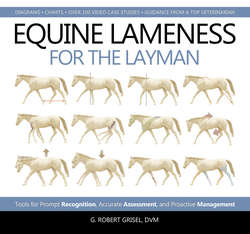Читать книгу Equine Lameness for the Layman - G. Robert Grisel DVM - Страница 31
На сайте Литреса книга снята с продажи.
ОглавлениеSECTION I
Our Responsibility to the Performance Horse
Biological tissue pathology does not come without cost. Even if the problem is mild, its persistence over an extended period of time can have permanent consequences with regard to an animal’s eventual comfort and performance. As time passes, our ability to successfully manage lameness becomes more challenging due to the natural progression of primary and secondary pathologies. Physiologic abnormalities that can be successfully treated (and in some cases reversed) early on may acquire varying degrees of permanence if left unaddressed for enough time. From this standpoint, the duration of lameness has an indirect relationship with the horse’s prognosis for future performance. Most veterinarians know this and would, therefore, prefer to treat acute severe inflammation (that recently developed) as opposed to chronic mild inflammation (that has been present for a long time).
The key to successful management lies in our ability to detect the problem during our “window of treatment opportunity”—that is, the phase when treatment will still be curative or at least highly effective. As many of us have learned the hard way, recognizing a problem after it has already reached the chronic phase makes successful management more difficult and, in some cases, impossible. We would all agree that management certainly gets more expensive as time goes on.
The key to maintaining long-term soundness in the horse entails proactive prevention (prophylaxis) as opposed to reactive treatment.
Once a problem has been recognized, we tend to be fairly proficient with regard to seeking professional consult, performing the necessary diagnostics, and implementing appropriate treatment. Veterinary research in the field of equine sports medicine has primarily been focused on improving diagnostic and treatment techniques that are implemented after the existence of a problem has already been confirmed. A major management dilemma, therefore, lies with the length of time between the onset of a problem and its recognition (fig. I.1).
I.1 Phases of Lameness Management
1. The onset of lameness. This represents the moment or period when the problem first occurs.
2. Local recognition of lameness. This represents the moment when the primary caretaker (owner, trainer, barn manager, friend, farrier) discovers the problem.
3. Veterinary confirmation of lameness. This represents the moment the veterinarian first becomes aware of the problem.
4. Clinical examination. This may be performed in the field or in a hospital setting. Physical assessment, passive and active soundness evaluations, palpation, flexion testing, and local anesthesia (blocks) are common techniques implemented during hands-on examination.
5. Diagnostic imaging and testing. Radiography, ultrasonography, thermography, nuclear scintigraphy, and magnetic resonance imaging (MRI) are imaging modalities commonly employed in modern work-ups of the lame horse. In some cases, clinical pathology (blood work) and histopathology (biopsy) are also performed to identify specific forms of disease.
6. Diagnosis. The results of clinical examination, diagnostic imaging, and other tests often enable the veterinarian to reach a diagnosis, which designates the specific cause of the horse’s lameness.
7. Treatment. Once a diagnosis is made, an appropriate treatment plan can be formulated for the horse. Corrective shoeing, systemic arthrotherapy (joint supplementation), local arthrotherapy (joint injections), extracorporeal shock wave therapy (ESWT), regenerative therapy (e.g. stem cells), and chiropractics are strategies frequently employed in the treatment of equine lameness.
We can shorten the length of time between the onset of lameness and its recognition by:
Improving the ability of the local caretakers (horse owner, trainer, farrier) to visually detect subtle lameness.
Improving dialogue between the local caretaker (horse owner) and veterinarian during the early stages of compromised performance.
I.2 Earlier Recognition of Lameness
Once the veterinarian is made aware of a performance issue, he or she can initiate the process of lameness confirmation, either through on-site evaluation or remote video review. The advent of telemedical (remote) evaluation allows the veterinarian to more quickly and easily become a part of the recognition process, a task previously restricted by time, distance, and expense. This concept typifies the foundation of equine sports wellness within the veterinary industry.
